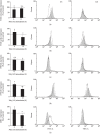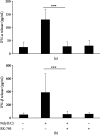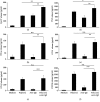The Response of Tissue Mast Cells to TLR3 Ligand Poly(I:C) Treatment
- PMID: 32185237
- PMCID: PMC7060451
- DOI: 10.1155/2020/2140694
The Response of Tissue Mast Cells to TLR3 Ligand Poly(I:C) Treatment
Abstract
Mast cells (MCs) are found mainly at the anatomical sites exposed to the external environment; thus, they are localized close to blood vessels, lymphatic vessels, and a multitude of immune cells. Moreover, those cells can recognize invading pathogens through a range of surface molecules known as pathogen recognition receptors (PRRs), mainly Toll-like receptors (TLRs). MCs are extensively engaged in the control and clearance of bacterial infections, but much less is known about their contribution to antiviral host response as well as pathomechanisms of virus-induced diseases. In the study, we employed in vivo differentiated mature tissue mast cells freshly isolated from rat peritoneal cavity. Here, we demonstrated that rat peritoneal mast cells (rPMCs) express viral dsRNA-specific TLR3 molecule (intracellularly and on the cell surface) as well as other proteins associated with cellular antiviral response: IRF3, type I and II IFN receptors, and MHC I. We found that exposure of rPMCs to viral dsRNA mimic, i.e., poly(I:C), induced transient upregulation of surface TLR3 (while temporarily decreased TLR3 intracellular expression), type II IFN receptor, and MHC I. TLR3 ligand-stimulated rPMCs did not degranulate but generated and/or released type I IFNs (IFN-α and IFNβ) as well as proinflammatory lipid mediators (cysLTs), cytokines (TNF, IL-1β), and chemokines (CCL3, CXCL8). We documented that rPMC priming with poly(I:C) did not affect FcεRI-dependent degranulation. However, their costimulation with TLR3 agonist and anti-IgE led to a significant increase in cysLT and TNF secretion. Our findings confirm that MCs may serve as active participants in the antiviral immune response. Presented data on modulated FcεRI-mediated MC secretion of mediators upon poly(I:C) treatment suggests that dsRNA-type virus infection could influence the severity of allergic reactions.
Copyright © 2020 Piotr Witczak et al.
Conflict of interest statement
The authors declare that they have no conflicts of interest.
Figures







Similar articles
-
Activation of mast cells by double-stranded RNA: evidence for activation through Toll-like receptor 3.J Allergy Clin Immunol. 2004 Jul;114(1):174-82. doi: 10.1016/j.jaci.2004.03.049. J Allergy Clin Immunol. 2004. PMID: 15241362
-
Mast cells generate cysteinyl leukotrienes and interferon-beta as well as evince impaired IgE-dependent degranulation upon TLR7 engagement.Indian J Exp Biol. 2014 Jun;52(6):589-96. Indian J Exp Biol. 2014. PMID: 24956889
-
Microglia recognize double-stranded RNA via TLR3.J Immunol. 2006 Mar 15;176(6):3804-12. doi: 10.4049/jimmunol.176.6.3804. J Immunol. 2006. PMID: 16517751
-
Functional evolution of the TICAM-1 pathway for extrinsic RNA sensing.Immunol Rev. 2009 Jan;227(1):44-53. doi: 10.1111/j.1600-065X.2008.00723.x. Immunol Rev. 2009. PMID: 19120474 Review.
-
Mast Cell Biology at Molecular Level: a Comprehensive Review.Clin Rev Allergy Immunol. 2020 Jun;58(3):342-365. doi: 10.1007/s12016-019-08769-2. Clin Rev Allergy Immunol. 2020. PMID: 31828527 Review.
Cited by
-
Toll-like receptor 3 (TLR3) regulation mechanisms and roles in antiviral innate immune responses.J Zhejiang Univ Sci B. 2021 Aug 15;22(8):609-632. doi: 10.1631/jzus.B2000808. J Zhejiang Univ Sci B. 2021. PMID: 34414698 Free PMC article. Review.
-
Inhibition of FGFR3 upregulates MHC-I and PD-L1 via TLR3/NF-kB pathway in muscle-invasive bladder cancer.Cancer Med. 2023 Jul;12(14):15676-15690. doi: 10.1002/cam4.6172. Epub 2023 Jun 7. Cancer Med. 2023. PMID: 37283287 Free PMC article.
-
Harnessing the Power of Mast Cells in unconventional Immunotherapy Strategies and Vaccine Adjuvants.Cells. 2020 Dec 18;9(12):2713. doi: 10.3390/cells9122713. Cells. 2020. PMID: 33352850 Free PMC article. Review.
-
Mast cells: Therapeutic targets for COVID-19 and beyond.IUBMB Life. 2021 Nov;73(11):1278-1292. doi: 10.1002/iub.2552. Epub 2021 Sep 21. IUBMB Life. 2021. PMID: 34467628 Free PMC article. Review.
-
Signal Transduction Pathways Activated by Innate Immunity in Mast Cells: Translating Sensing of Changes into Specific Responses.Cells. 2020 Nov 4;9(11):2411. doi: 10.3390/cells9112411. Cells. 2020. PMID: 33158024 Free PMC article. Review.
References
MeSH terms
Substances
LinkOut - more resources
Full Text Sources
Medical
Research Materials

